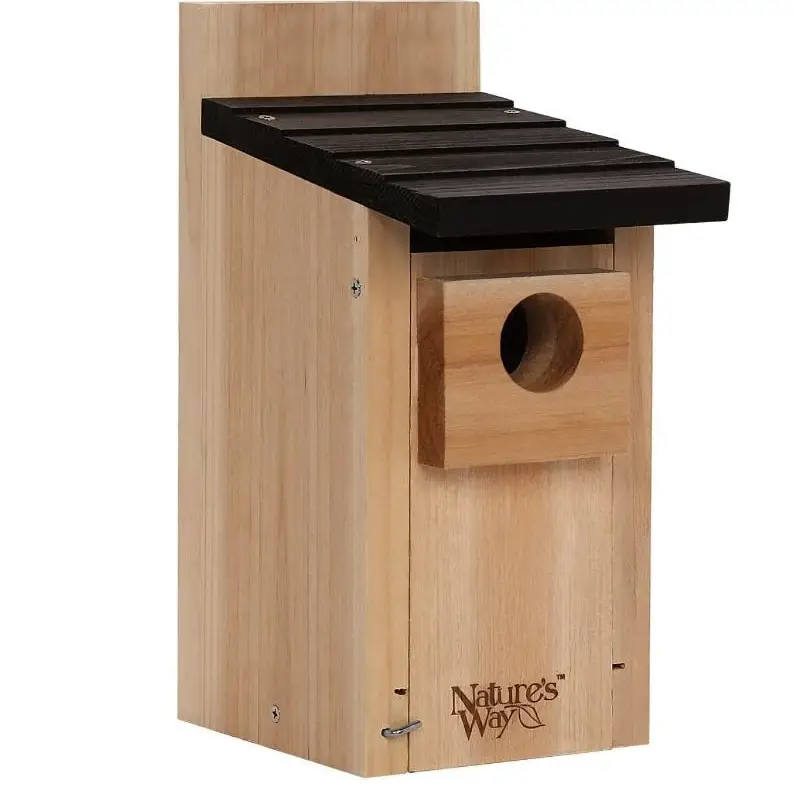
- Item Weight 2.65 pounds
- 8.13 x 5.5 x 12 inches
- Bluebird Box House
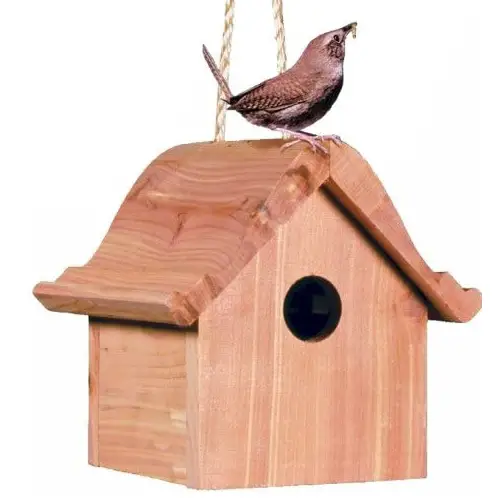
- Brand Perky-Pet
- Color White
- Material Wood
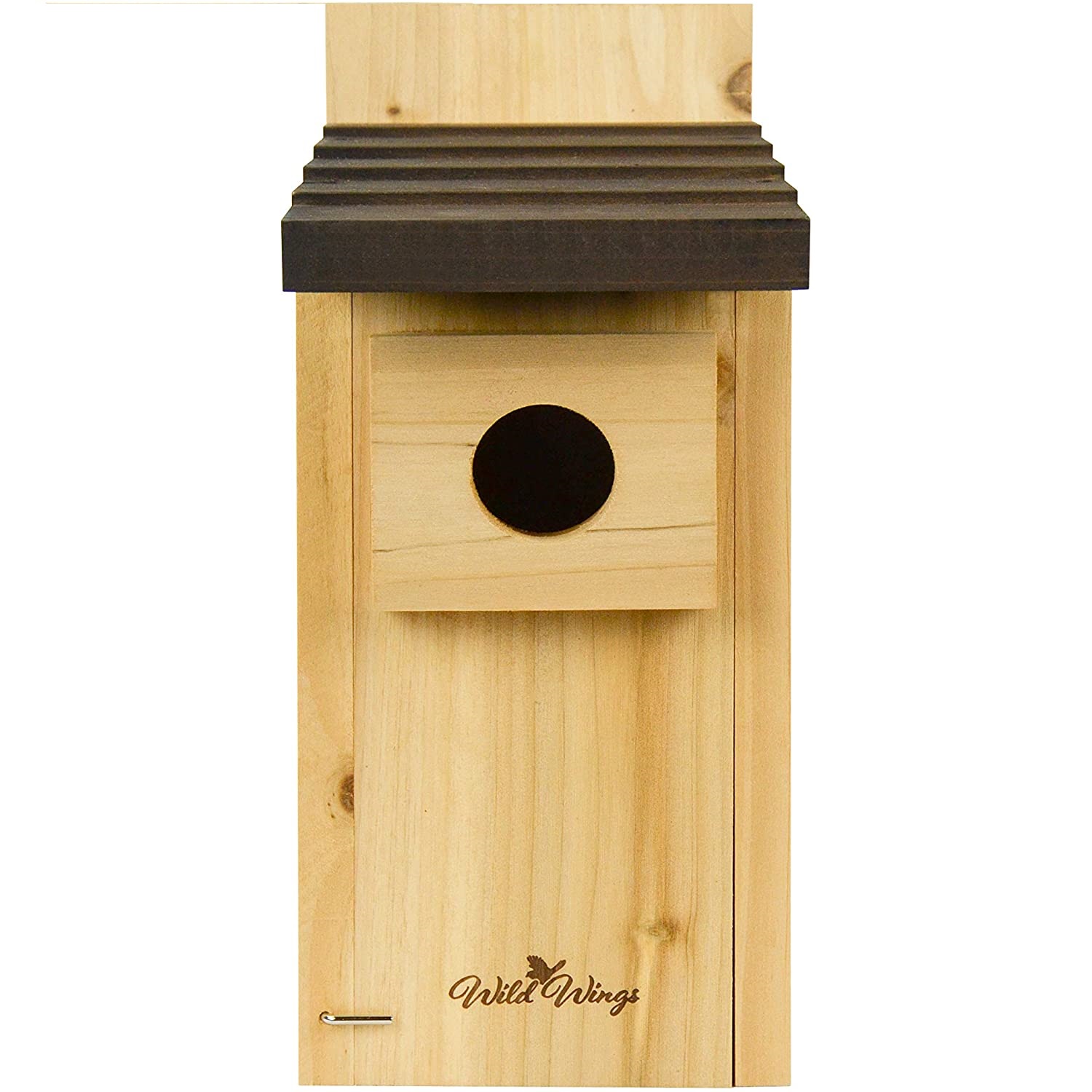
- Item Weight 1.98 pounds
- Wild Wings
- 8.13 x 5.5 x 12 inches
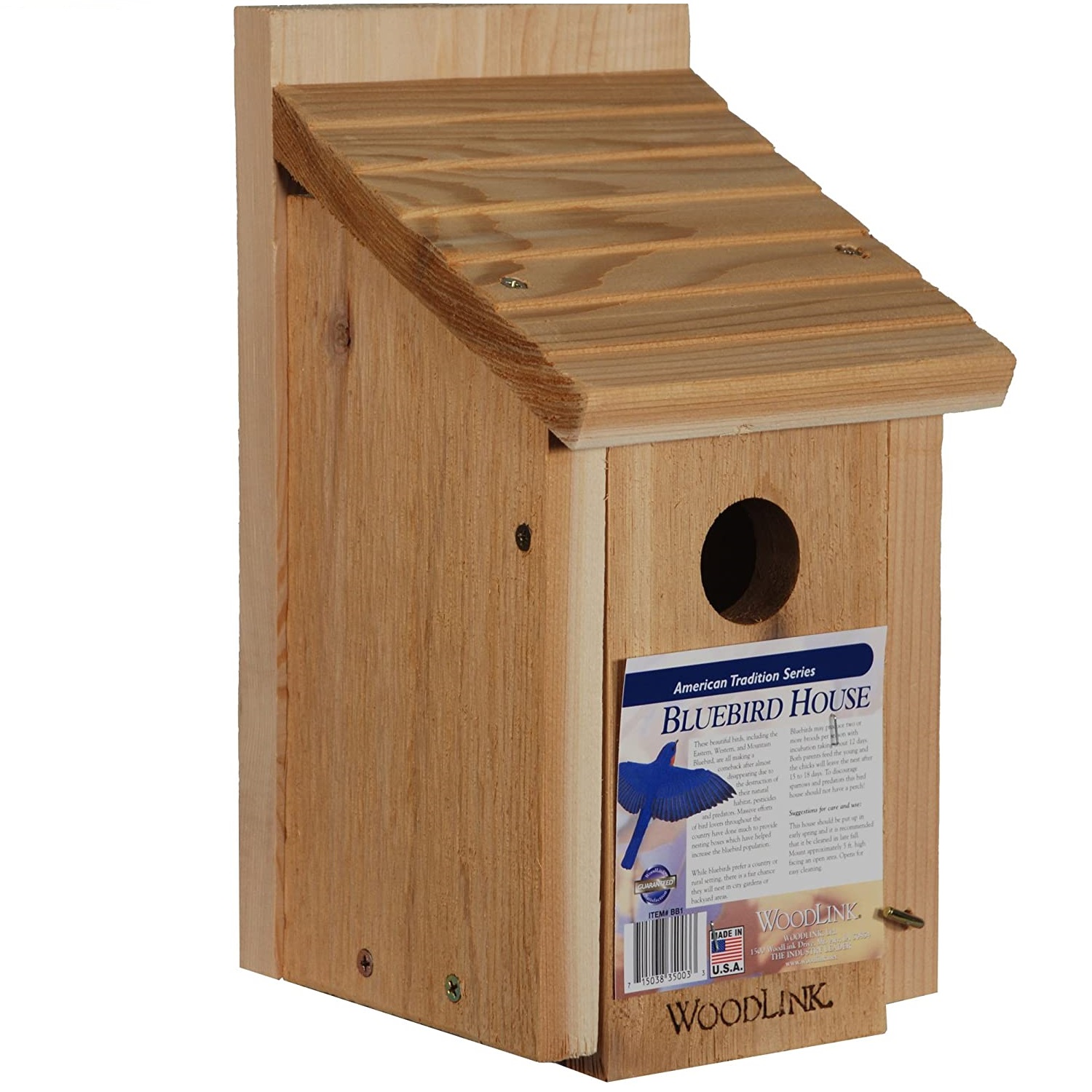
- Brand: Woodlink
- 2.99 Pounds
- Kay Home Products
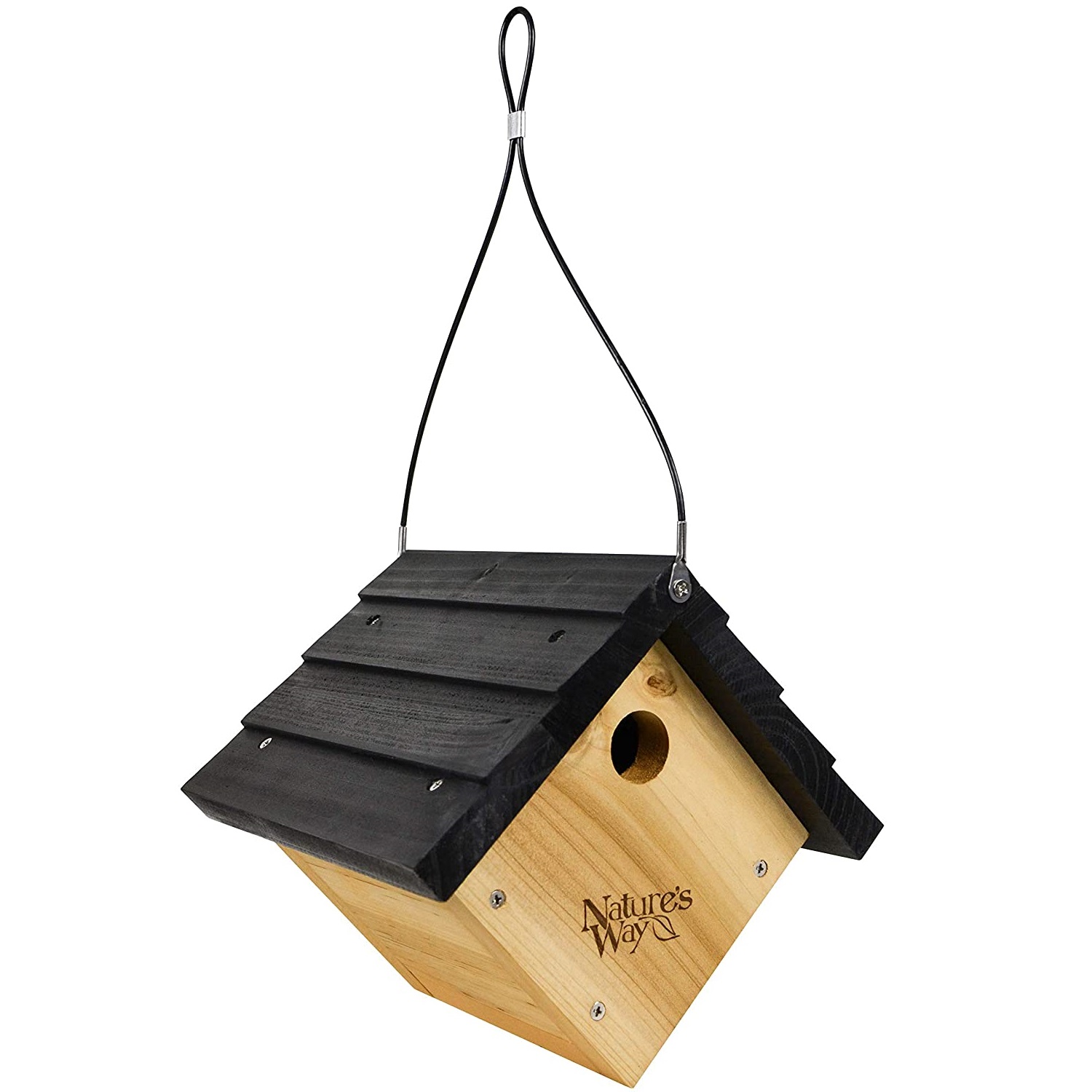
- Item Weight 2.08 ounces
- Natures Way
- Brown
Choose the Best Bird House
Customer’s Choice: the Best Rated Bird Houses
2 users answered this survey. Please help us improve this review!
Birds are a common sight in our backyards. We have all seen the cute little sparrows or the big, colorful cardinals. In addition, it is nice to see them in cute and spacious bird houses hanging outside your house.
Benefits of birdhouses:
- Birdhouses provide shelter and protection to local birds;
- A birdhouse can also be a great piece of decor for your yard or garden;
- Some bird species will only nest in manufactured structures, as opposed to nesting naturally on trees or cliffside;
- The most common types of birds that use these homes are bluebirds, wrens, chickadees, woodpeckers and nuthatches;
One of the most important things you can do for your backyard birds provides them with shelter from predators and bad weather conditions. This article will review 5 different birdhouses and offer tips on how to choose one for your yard.
Table of Contents
Nature’s Way Bird Products CWH3 Cedar Bluebird Box House – the Editor’s choice!
 Nature’s Way Bird Products CWH3 Cedar Bluebird Box House will make it a little bit easier to help out those cute little cedar bluebirds in your neighborhood. With cleanout doors you’ll be able to maintain the house for generations, and will resist insect damage with rot-resistant premium cedarwood.
Nature’s Way Bird Products CWH3 Cedar Bluebird Box House will make it a little bit easier to help out those cute little cedar bluebirds in your neighborhood. With cleanout doors you’ll be able to maintain the house for generations, and will resist insect damage with rot-resistant premium cedarwood.
This nifty box also has two installation options that allow flush mounting or pole mounting, guaranteeing your nautical neighbors have plenty of flapjacks – even if their new place is on the tree rather than ground level!
Constructed of cedar and finished with water-based protective stain, this shelter not only keeps out predators but also allows fresh air to reach their small little bodies all while being sheltered by thick walls and overlapping roof panels.
Perky-Pet 50301 Wren Home – the best for easy hanging!
 This spacious bird home offers a Dutch-style roof with rope for easy hanging. The preassembled nesting cup and perch are perfect for all seasons of the great outdoors, and it stands 6.5 inches tall. With dimensions of 6.52 x 7.49 x 14.13 inches, this wooden birdhouse is made from aromatic cedar to guard against insects and weather.
This spacious bird home offers a Dutch-style roof with rope for easy hanging. The preassembled nesting cup and perch are perfect for all seasons of the great outdoors, and it stands 6.5 inches tall. With dimensions of 6.52 x 7.49 x 14.13 inches, this wooden birdhouse is made from aromatic cedar to guard against insects and weather.
Let the little birds flutter right into this chic, modern house. With a simple hanging mounting system, they won’t have a problem finding it!
The welcoming Perky-Pet 50301 Wren Home is crafted from aromatic cedar, making it weather resistant and insect-repelling. The Dutch-style roof and rope for easy hanging are inviting to all the local feathered friends in your tree’s branches.
Wild Wings WWCH3 Cedar Blue Bird Box House – the best for easy cleaning!
 This bird box home is crafted from nature-resistant Premium Cedar, allowing for easy care and pest-free living space. The air vents make it possible to have fresh oxygen circulating through the house while closed up tight against outside dangers with the cleanout door.
This bird box home is crafted from nature-resistant Premium Cedar, allowing for easy care and pest-free living space. The air vents make it possible to have fresh oxygen circulating through the house while closed up tight against outside dangers with the cleanout door.
Crafted from insect and rotted resistant materials, this box house is able to withstand any weather conditions your feathered friends can throw at it.
This cedar beauty can become the perfect addition to any backyard because it never needs painting or staining!
Woodlink Wooden Bluebird House – the best for design!
 This piece of natural cedar was designed to attract our favorite bird: bluebirds. Providing one 1/2 inch hole for them to fly through and perch on top of, and a 1/2 inch air ventilation gap at the top of this handmade product makes it ideal for eastern bluebirds. The design also includes a 1/2-inch air ventilation gap at the top and a drain hole at the base, so all your rainwater won’t seep in forever.
This piece of natural cedar was designed to attract our favorite bird: bluebirds. Providing one 1/2 inch hole for them to fly through and perch on top of, and a 1/2 inch air ventilation gap at the top of this handmade product makes it ideal for eastern bluebirds. The design also includes a 1/2-inch air ventilation gap at the top and a drain hole at the base, so all your rainwater won’t seep in forever.
A modern take on the classic birdhouse, this chic bluebird home is bound to bring those backyard birds out of hiding.
Constructed of reforested, kiln dried, inland red cedar, the Woodlink Wooden Bluebird House has been ornithologically designed to attract bluebirds and conveniently comes equipped with a 1/2-inch hole for eastern bluebirds.
Nature’s Way Bird Products CWH1 Cedar Wren House – the best for durability!
 The Nature’s Way Bird Products CWH1 Cedar Wren House is our most popular house and for good reason! This three-sided, durable cedar birdhouse with vinyl coated steel hanging cable will offer your small night birds a safe place to call home.
The Nature’s Way Bird Products CWH1 Cedar Wren House is our most popular house and for good reason! This three-sided, durable cedar birdhouse with vinyl coated steel hanging cable will offer your small night birds a safe place to call home.
The large 1 1/8-inch hole’s diameter keeps out pesky sparrows and larger predatory birds while allowing the smaller bird neighbors through. Cleaning is easy too. Thanks to the two captive clean-out doors on this product, you’ll be able to get in behind your investment and catch any droppings or gather dirt before they have time to accumulate and start causing serious damage.
This cedar wren house is designed to withstand the natural decay that can affect wood and keep out much larger birds like sparrows. The manufacturer also included a vinyl-coated hanging cable so you won’t have to do any hammering or drilling on your own.
The Buyer’s Guide
Birdhouse Types:
1) Wall-mounted
Wall-mounted birdhouses are great for those who have a lot of space and don’t want to worry about the potential mess. These types of houses mount securely on any hard surface, such as your garage or even an outdoor brick wall. The downside is that they’re not very portable if you need them somewhere else. Some models include perches so birds can rest while waiting their turn at it; others offer front doors with little “windows” to better see inside without having to open up the house itself (which would let out all the heat). You’ll find these mounted just about anywhere there’s available space – some people will install one near their lawn chairs outside so they can enjoy watching nature right from where they take a seat.
Make sure to install the house securely and out of reach from predators. You may also want to invest in a cinch-tight cover, which will keep it nice and snug for those really cold days.
2) Pole-mounted
Pole-mounted birdhouses are a great option for people who don’t want to mount their house on the ground and can provide some security from predators. These pieces of hardware also have wide bases which is an important safety feature, as with all feeders it’s very important that they not topple over into high-traffic areas where pets or small children may go if unattended. They’re best suited for backyards because there should be plenty of clearance above them in order to allow birds access without getting too close to any electrical wires or branches overhead.
The design of these birdhouses generally makes them look more attractive than most other designs because often they will sit higher off the ground so that you’ll see just the roof when looking at them. That way, they won’t be an eyesore in your yard but can still provide shelter for birds and help you to attract more into the area with their larger size.
Pole-mounted birdhouses are also perfect if you have a tall tree that needs pruning because it’s easy to attach them directly onto the trunk of any tree – whether or not there is already another type of feeder mounted on it as well. This will allow both types of pole mounters to find a safe haven from predators without endangering one another and forcing other homeowners to put up with extra noise or unsightly additions out front when all they want is a nice green lawn.
Pole-mounted birdhouses offer little protection from predators so they’re best for backyards or areas where there are no ground-level threats.
They shouldn’t be installed near any electrical wires or branches overhead to avoid compromising their stability and harming birds in the process. Pole-mounted birdhouses can be mounted onto trees with feeders already on them, which is great if you plan to prune your tree because it won’t interfere with anyone else’s yard.
3) Hanging birdhouses
A hanging birdhouse is a great way to attract and provide shelter for many different species of birds. The best thing about them, you can put them virtually anywhere. Hanging birdhouses are often used in gardens or on the edges of wooded areas.
This is because they blend into their surroundings more easily than other types of home-like dowels that can be nearly impossible to find if you don’t know where to look (or have an idea with what type of trees grow around your home). It’s much easier when it comes time to clean out the old nesting material from these homes – just use a broom and sweep off all that gunk while standing on solid ground.
4) Nest boxes
A nest box is a type of birdhouse that allows birds to enter and exit through the front, back or both. They are usually shaped like an elongated triangle with one side open for entry. Some models may have perches located on either end making it easier for the birds to find shelter during inclement weather and others might include nesting material inside so that they can build their nests.
Migratory species often seek out these types of homes because they offer protection from predators when not in use by humans or other animals such as squirrels that prefer cavity houses instead. Nest boxes also protect eggs from being eaten by other animals including raccoons who could climb up into them if found above ground level.
Nest boxes are one of the most popular types because they can be used with a variety of birds. By mounting them in trees, on poles or walls, you will attract different breeds like Eastern Bluebirds and Barn Swallows just to name a few examples. They come in many sizes as well so there is bound to be an option for your space whether it’s large or small.
There are usually four options when sizing nest boxes – mini, standard (14×20 inches), jumbo (18×24 inches) and super jumbo (24x 24 inches). You should choose based on what type of birds you want to see nesting in your box.
The coloration of the house is also a key feature to take note of since it will determine which birds are more likely attracted to it. For example, if you want Eastern Bluebirds then go with blue or light colors like white and brown while for Purple Martins choose green or red (though this may not work as well).
Nest boxes come in many shapes: traditional boxes, tube-shaped ones that resemble beehives, round and dome-shaped ones too! So whichever shape you prefer there’s sure to be one out there for you.
5) Apartment style
The apartment-style birdhouse is a miniature replica of an apartment building. It has two entrances (each with its roof) and can easily have indoor plants added for the birds to use as nesting material. The design makes it easy to clean out too. With all these features, this birdhouse would be perfect for any type of creature that likes to live in a home-type setting such as woodpeckers, swallows or wrens.
This style doesn’t come cheap though at $45-$65 depending on size but if you’re looking for something more realistic than other styles which might frighten away potential residents then this one is worth considering.
Apartment-style birdhouses come equipped with features such as platforms to sit and watch the birds, feeders built-in so you don’t have to fill them up yourself and roof vents to allow airflow through the house.
The only downside of these types of houses is their small size – they won’t be enough room for large families but also not big enough to attract groups of different species at once (unless you add multiple together).
These types of models will typically come with hooks that can hang on the side of your house or from any nearby tree limbs, allowing you to place them where they’ll do the most good without taking up much room at all. This type is also popular because it doesn’t require drilling into anything before hanging and comes in so many different styles and colors.
6) Gourd birdhouses
Gourd birdhouses are a unique and creative way to make your backyard wildlife-friendly. Gourds can be grown in the garden or purchased at stores, then drilled with holes for nesting birds to enter. The gourds will eventually dry out but you’ll have created a sustainable habitat that nurtures life all year long.
They come in various shapes and sizes with some having cutouts to allow you to see inside the gourd, which can be fun if you’re trying to watch from your window or deck.
A gourd birdhouse is one of the most popular styles because it has an open bottom that allows nesting material such as straws or shredded paper to fall out onto the ground where they will decompose over time. This makes cleaning simple since there won’t be any loose material on top of the house when you clean it out so often, these houses last much longer than other types before needing replacement due to mold buildup. The holes at either end of the gourd allow rain to drain out which is a major benefit for anyone living in wetter climates.
The only disadvantage of such a birdhouse is that it can be difficult to find one that looks like an actual house and not just a large white cylinder sitting on your windowsill. They also come with pre-drilled holes so you might want to consider using this type as decoration outside if you don’t have any birds right away or risk having them fly into these openings during their first few days inside, leading them back toward an open door where they’ll escape.
Birdhouse Sizes
The size of the birdhouse you buy should be proportional to the type of birds who will use it:
- the smallest houses are for Nuthatches, Chickadees and Titmice;
- medium-sized ones can accommodate a variety of smaller species such as wrens or sparrows;
- larger homes suit small woodpeckers like Downy Woodpecker, Hairy Woodpecker, Northern Flicker or (occasionally) Pileated Woodpecker;
- very large birdhouses are intended for owls or hawks that need an enclosed “platform” home with plenty of space inside and out at all levels;
The size of the birdhouse is very important. The bigger the better, as long as it’s not so big that birds can’t get in and out easily.
A good rule of thumb is to choose a birdhouse with an entrance hole at least 3 inches from the ground or floor where you want your bird feeder. This will give them plenty of room to enter and exit without compromising their safety.
Also consider how large this space should be for future needs if they need more time before hopping off, such as when feeding young ones or tending eggs. Some models come with nesting areas inside which are larger than others but also have a back opening just like regular openings. This feature lets you see inside to check on the progress of fledglings without disturbing them.
The size and depth of a birdhouse are also important because it determines how large the cavity can be, which directly affects space for roosting. Nesting cavities should measure at least five inches deep with an opening that’s big enough (about two inches) for birds to enter.
If you’re looking for a model where one or more eggs nestled in straw might fit, then consider purchasing a house with nesting compartments instead. These usually have small entrances as well as back openings so that they’ll allow access to different parts of the cage while preventing predators from getting into trouble themselves when trying to get their prey out. The following are some of the best birdhouses for eggs and straw.
Birdhouse Materials
The best birdhouses come in a variety of shapes, sizes and materials:
- Wooden birdhouse designs are often styled after the Tudor design with gables on either side or they may be more modern looking. These can last for decades if cared for properly however it’s important to seal them periodically so that moisture doesn’t get trapped inside which could lead to mold growth as well as other problems like rot from termites nests. This is something that needs to be done regularly according to experts otherwise you’ll find yourself replacing your wooden birdhouse sooner rather than later because water damage will eventually set in and destroy it much faster than anticipated;
- Metal birdhouses are an ideal choice for those who live in or near a salt-water environment. This is because metal does not corrode like wood and they also don’t attract termites the way that timber will which means it’s much less of a headache to maintain them. The downside is that birds may find this cold so you’ll need to place some type of grass, leaves or other organic material inside (such as moss) on the flooring surface if possible, otherwise your new home might be deemed unsuitable by your feathered friends;
- A thistle birdhouse design resembles what most people would associate with desert dwellings which could make this option something worth considering if you want a more natural style option. These can either be made from wood, metal or plastic and they are often designed to look like a rock which will offer some protection to the birds inside. The downside is that this may not be an ideal choice for those who live in regions with high humidity levels because it’s likely that your birdhouse could become infested with mold over time due to dampness;
- Wicker birdhouses have been used since ancient times as a natural material found all around us so it makes sense why wicker birdhouses have finally come into existence now too! It can be difficult finding them online but there are still plenty of places where you’ll find these beautifully crafted homes built specifically for our winged friends. These don’t require any type of upkeep other than removing any debris that might accumulate inside over time but they are not recommended for those who live in regions with high humidity levels because it’s likely the wicker will become infested with mold and other problems due to dampness;
- A cardboard birdhouse is a great choice if you want your new home to be both affordable as well as easily accessible (it can be purchased online or picked up at your local hardware store). This type of design doesn’t require any kind of maintenance or upkeep which means there won’t be much required other than sweeping out the interior from time to time so that dirt, leaves and feathers don’t build up. There are some drawbacks though such as this may not offer enough protection against predators or the weather that could make this a less than ideal choice for those who live in regions with high humidity levels or extreme cold;
- A bamboo birdhouse is an excellent choice for someone who wants to go completely green and sustainable from start to finish. This type of design typically consists of two slats that are held together by four stakes so it’s important when choosing your new home to ensure that you purchase one where each side measures at least 12 inches wide otherwise they’ll be too narrow inside and won’t suit most birds very well. It also helps if the flooring has some kind of covering (such as moss) on top because these can get rather chilly otherwise due to their lack of insulation properties found in other designs;
Birdhouse Installation
Birdhouses can be installed on the ground, or in trees. Sometimes birdhouses will even attach to buildings such as a home’s eaves or with an outdoor wall-mounting bracket. The best place for your birdhouse installation is where you’re going to get the most exposure and visibility from passersby like cars driving by, cyclists biking past, etc. If you want it more hidden then install it higher up so that birds have climbing access but don’t block any views of other people looking at your house from passing vehicles.
Most birdhouses should be installed before the end of March, in time for nesting season.
Your best bet is to find an outdoor surface that has been graded so as not to allow water drainage from rain or snowmelt. In regards specifically to tree installation, make sure there is no bark on the trunk that would provide protection for birds against predators such as squirrels. To protect against this issue, many homeowners opt for steel spikes instead of exterior mounting brackets when they want stability but need more flexibility than can be achieved with tree screws.
If your surface is not graded, you may be able to install the birdhouse on a post or pole (again, specific instructions will come with each product). If so, make sure that it’s at least four feet off of the ground and it does not have any large branches nearby that could provide shelter for predators. The poles should also extend an inch past the base of where they are installed into the soil in order to secure them better against windy conditions.
A good general rule of thumb when installing a birdhouse: follow these three guidelines; location, security, and cleanliness. A well-placed house can attract many birds who would live there happily for years – but without proper installation precautions taken, the house may not be occupied for more than a few weeks.
As with any home, cleanliness can go a long way to making it inviting and hospitable. Be sure to check your birdhouses regularly so that birds living there don’t have their nests or eggs destroyed by parasites like wasps and mosquitoes.
And, of course, if you’re installing an outdoor tree-mountable birdhouse in wintertime, make sure it’s securely fastened to protect against ice storms that could destroy them. If they are attached inside of a gutter system on the roof of your house (instead of outside), then freezing water will cause catastrophic damage as well when pipes freeze and burst – this is why many homeowners opt instead for placement systems with suction cups or screws to affix them.
Birds need water to drink, and so it’s important that your birdhouse has a way for rainwater and snowmelt to escape – this could be as simple as drilling holes in the bottom of the box! A drip tray can also be installed under the house if needed.
In general, clean out any remnants from previous nesting seasons such as feathers, nest fragments, etc., before installing new nests inside. You may want to consider also adding more perches around your yard for birds who are not using the houses you’ve provided. They like stepping stones too. And lastly, watchful homeowners will note when their favorite species is visiting and welcoming them by leaving small treats such as seed or bread crumbs for them to eat.
Birdhouse Cleaning
It is important to keep your birdhouse clean so that pests do not invade. The best way to do this is by washing it with soap and water, then spraying it down with ammonia or bleach solution before letting them dry in the sun. Once they have dried you can paint over them again if desired. If a heavy infestation of bugs has happened, take the entire birdhouse apart into its individual pieces and wash each one individually instead of trying to scrub off their body parts from inside your birdhouse.
Be sure not to get any liquid directly on birds as they will either be scared away or die from drowning due to what you are using for cleaning purposes. Birds constantly need nesting material so make sure there are some leaves available for easy access to clean up any messes that occur.
You don’t want to be attracting pests such as insects, that can spread disease and kill off your feathered friends. Here are some helpful tips to keep things sanitary:
- Spray down any wood with water and household cleaner before letting birds back in. This will help remove dirt, dust, mold spores or other contaminants from where the birds live;
- Place the new straw on the bottom at least once a year. Replace if necessary more often depending on how many times you turn over their home each day/weekend;
- Remove droppings from the bottom of the birdhouse daily or as needed;
- During cold winter months, open up roof and sides with a drill to let in the fresh air;
FAQ
How to attract birds to birdhouses?
Birds are attracted to insect prey, water sources and nesting materials. So make sure the birdhouses have some of these things:
- a roof for shelter from the rain;
- holes to provide cool air circulation in warm weather as well as protection against predators during bad weather;
- space inside the house for birds to build nests;
Combine these provisions with nearby food sources such as planted seed or suet feeders (to attract insects) and you may start attracting more birds.
What is the best size for a birdhouse?
A small birdhouse is preferable for smaller birds. Larger birds, such as a raven or crow need larger houses to accommodate their size. For example, the best height should be at least nine inches from ground level if you are interested in attracting hummingbirds because they have short legs and require an easy step into the birdhouse.
On average, most will stand around 10 inches high. That may not sound like much but it can make all of the difference when trying to attract certain species of birds. In addition, while approximately four square feet is standard for this type of shelter expect that some new models range anywhere from 6 to 8 feet wide with two entrances depending on your needs – one for coming out and another for going back inside again after it rains.
The best size for a birdhouse will depend largely on the type of birds that it is intended for and their physical attributes to height and weight; this also depends if they need an easy entry or not due to any handicaps such as leg length from old age or disability (i.e., can’t jump).
If there’s one thing we know about nature, it’s that every animal has specific needs when choosing shelter – if only because some animals like small spaces while others prefer more roomy accommodations with multiple entries. For example, hummingbirds have short legs so they require a low entry point.
A shelter that is too large will have a higher probability of attracting bigger birds who are not interested in the house anyway, such as seagulls or hawks because they can’t fit inside and won’t nest there. Smaller species may also find it difficult to maneuver into a larger home due to its size and height that could lead them to be willing participants by going back out again once entering the front door.
On the other hand, if you build your birdhouse with an entry much lower than nine inches off the ground this means that smaller animals including squirrels, rats, snakes-even cats would be able to get inside without any trouble. This makes for an undesirable nesting spot for native wildlife because it’s too easy for predators to sneak in and take over the house.
Why don’t birds use my birdhouse?
A few reasons are:
- You have a birdhouse that’s too small – some birds need more space than others;
- Your birdhouse has unsuitable features, like lots of wide-open spaces or big gaps between branches and posts that make it easy for predators to snatch up your feathered friends inside;
- The nesting material might not be appropriate for what type of birds you’re trying to attract (e.g. if you don’t provide any kindling). Or maybe there aren’t any other good nesting sites around so they’re just being picky about where they’ll settle down;
Do you put anything in a birdhouse?
No, you don’t put anything in a birdhouse. You place it on the ground or hang it from something so birds can build their nests and lay eggs there. Birds are naturally drawn to these houses because they provide protection for their young as well as warmth during cold weather months. The best ones even allow them to have access to food sources such as seeds, water and bugs!
Should you put a perch on a birdhouse?
A perch is not necessary for a birdhouse. The perches are often used by birds to sit on and groom, but other animals can use them as well. They also make it easier for birds that don’t have wings or difficulty flying to access the nest box.
Should you drill holes in the bottom of a birdhouse?
Drilling holes in the bottom of a birdhouse helps to keep it dry. It also prevents any predators from entering. Without holes, water will seep between the floorboards and eventually fill up inside, causing mold and mildew which is not good for your birds. If you add more than one hole then they should be spaced evenly so that small animals cannot enter through the gaps created by them; this includes rats, mice or snakes!
Do robins like birdhouses?
Robins are among the most common birds to find in and around birdhouses. So yes, they do like them! However, you should know that they prefer a more natural shelter-type habitat than an artificial one.
Do hummingbirds go in birdhouses?
No, because hummingbirds do not need a nest. They feed on nectar and insects from flowers or other sources. However, you will be able to attract more birds if your birdhouse has a perch near the entrance where they can rest before entering the house for shelter.
Should you paint a birdhouse?
There is some debate about whether you should paint a birdhouse. Some say that painting the house can create an unappealing visual barrier for birds, and instead of being welcoming it may be seen as threatening or intimidating. Others claim that painted houses are more likely to catch someone’s eye and thus will get more attention than unpainted ones.
The choice on this question depends largely on what kind of birds live in your area – predators like hawks might not bother with an attractive house if they know there’s no prey inside, while brightly colored houses (especially those with UV reflective colors) will attract the attention of smaller songbirds from afar.
What color attracts birds the most?
Birds are attracted to the color red. This is why many birdhouses have red roofs and walls. Red attracts birds because it looks like the sun, which they see as a warm place with lots of food for them to eat in trees. Most rainforest habitats are also very colorful, so bright colors stand out against green leaves and plants or brown branches. Birds can often find their nests by looking for brightly colored homes where other birds live nearby – which means you don’t need an elaborate display if your goal is simply attracting new tenants.
How to make a DIY birdhouse?
If you have the skills and tools, there are a number of techniques to make your birdhouse. A simple way is to drill holes in an old log or tree stump with a power drill, but many people don’t enjoy this project due to dirt and bugs getting into the home they’ve created for birds. Another option would be cutting out cedar board panels with woodworking saws from sheets of corrugated roofing material (commonly called “tar paper”) that has been glued together on one edge along its length using contact cement.
The boards can then be cut apart by hand, drilled through both sides at appropriate intervals (typically every two feet), nailed together again so that all the ends face outward. Put over a hole in a stump or tree trunk, and the interior walls can be lined with wood shavings (or anything else you think will make it more attractive to birds).
What are the best birdhouse brands?
The best birdhouse brands are ones that have a long-standing reputation for quality and service. A few of the top companies include:
- Nature’s Way Bird Products;
- Perky-Pet;
- Wild Wings;
- Woodlink;
Useful Video: Selecting the Best Bird Houses, Feeders, and Seed
Final thoughts
Hopefully, you’ve found this article helpful in finding the best birdhouse for your outdoor space. Remember to do some research on the type of birds that exist near you so that you can find an appropriate home for them. If not, or if you have any other questions about backyard birdhouses, feel free to contact us.

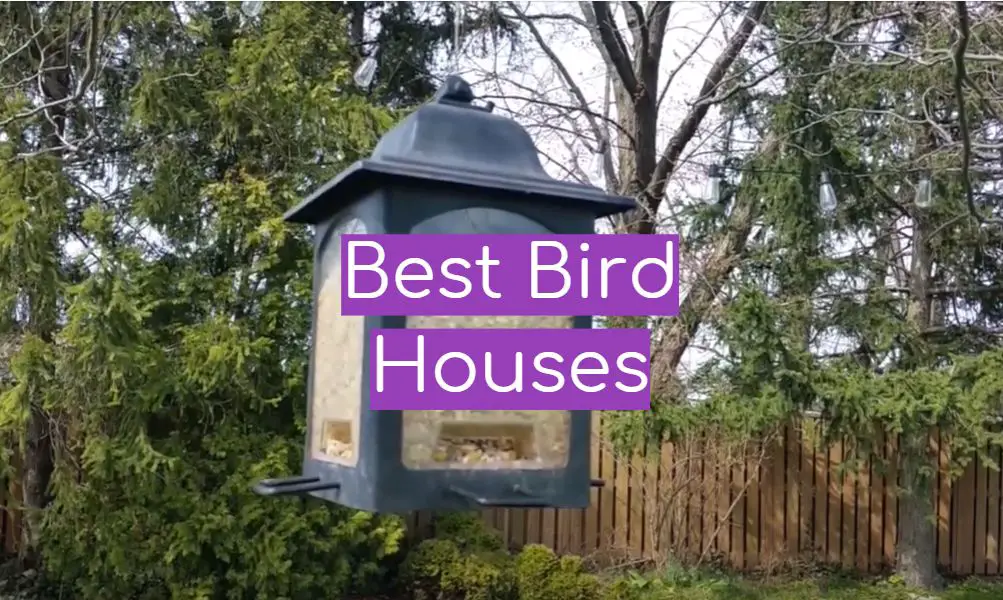

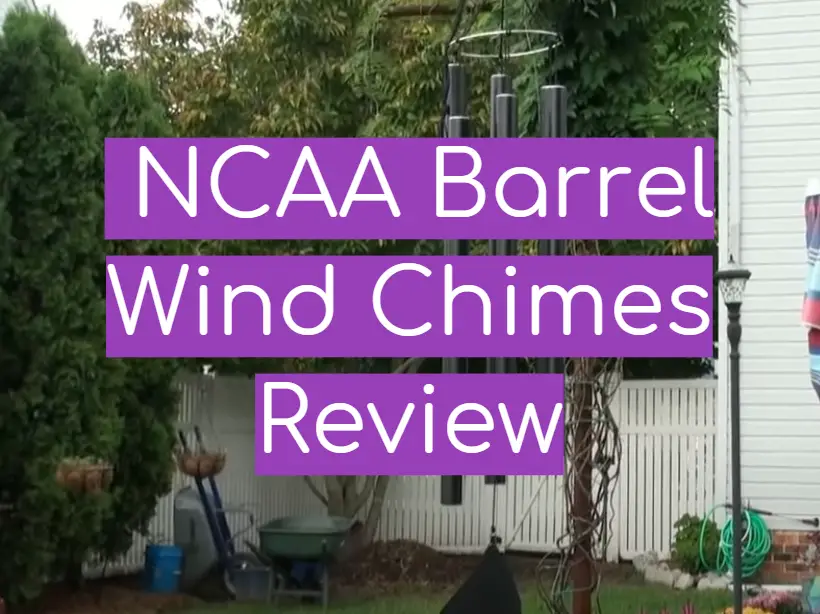

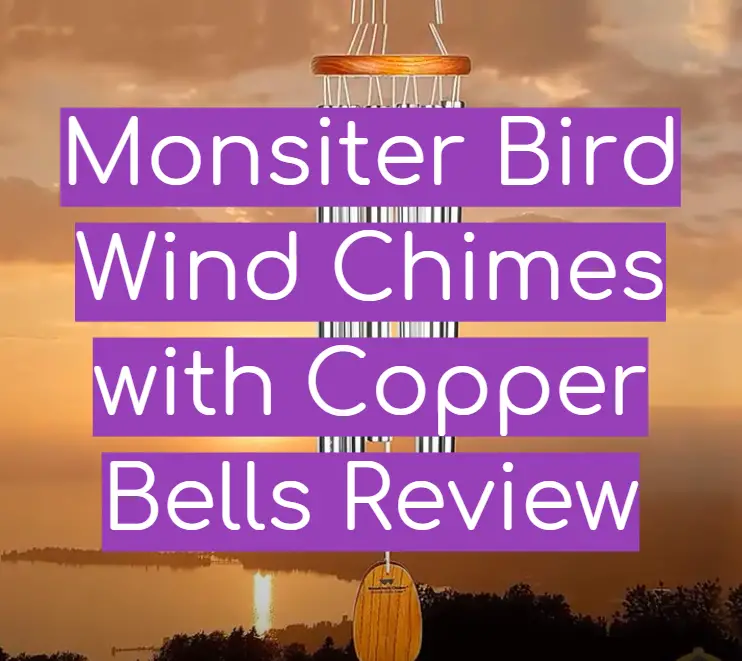
Leave a Reply